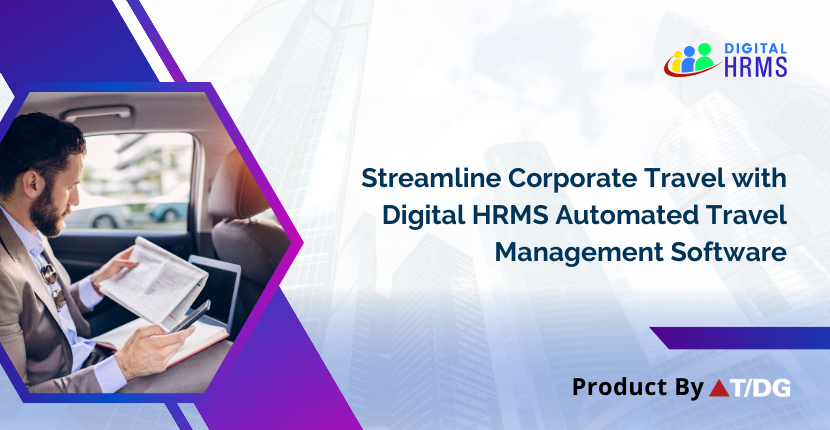Transforming Corporate Travel Through an Automated Travel Management Software

In the world of corporate travel, it is often a daunting task to keep record of the travel and its related expenses and apply for its reimbursements, especially when done manually. In the recent years there has been technological revolution in every field of HR management. To have a smooth experience in travel and its reimbursement, it requires a systematic management. The corporate travel industry generally can serve companies of any scale across all geographies and sectors and hence involves high complexity. To streamline corporate travel, an automated travel management system is highly required and simplifies the HR task.

Steps of Choosing the Accurate Travel Management Software
For implementing the Travel Management System suiting your organizational needs, following steps must be followed:
1. Requirement Assessment and Planning:
The first step for procuring any travel management software is the requirement analysis. Outline your organizational goals and objectives clearly.
The main points covered here are Cost Reduction, Streamlining Travel Process, Data Transparency and Getting Insights
- Cost Reduction: It is up to your organization to aim on cut travel-related expenses, enforcing travel policies, and tracking expenses effectively are very helpful.
- Streamlining Travel Process: For your organization if efficiency is a priority, select an appropriate platform to automate approval workflows, simplify booking processes, and maintain a single platform.
- Data Transparency: To maintain transparency in all the processes, from raising requests to approval and finally reimbursement of expenses helps the employees get updates regularly.
- Getting Insights: Focus on analytics and reporting capabilities of the application, which can provide insights into spending patterns, compliance rates, and potential savings. This in long run will help your organization carve new policies or take steps to avoid unnecessary expenses.
2. Customized Travel Policies
Getting customized travel policies specific for your organization implemented through the travel management platform ensures that it aligns with your organization’s specific guidelines and requirements. Below are the points to consider:
Expenditure Limits: According to the business unit or organization as a whole you can define limits for spending in different categories, such as flight charges, accommodation, and meals. This step ensures that excessive spending can be avoided and also promotes agreement with budgetary limitations.
Choosing Ideal Travel Partners (Vendors): For your organizational travel needs, you can specify a list of preferred vendors for flights, hotels, and other services. You can previously choose those vendors in agreement with your organizational policies. The travellers have the option to choose that offer the best value and potential discounts.
3. Approval Workflows
Based on the business units or for the overall organization you can configure automated approval workflows where you pre-assign limits or other specific criteria. The concerned authorities of the departments can review and approve other travel requests. Finally, the accounts section can reimburse the expenses incurred in the travel process.
4. Integration of Travel Management Software
The travel management software should have the ability to integrate the platform with existing systems, such as financial software, HR databases, and CRM systems. Integration ensure data accuracy, reduces manual work, and offers a complete view of all the HR processes.
5. User Roles and Permissions
Your travel management software should have well-defined different roles-based users with their assigned responsibilities. The roles may include travel manager, traveller, administrator and accounts manager. Previously, what actions each role can perform within the platform are decided and implemented accordingly.
6. Give Employees Appropriate Training
Training sessions need to be customized as per the needs of different user groups, such as travel managers, administrators, and travellers. Address their specific roles and responsibilities within the platform. Train the users with the platform’s layout, menus, and navigation paths, and ascertain they know different features and sections as well as how to access.
Ideal Travel Management System Features:
1 Android and iOS Compatibility of the Travel Management Software
The two major mobile operating systems are Android and iOS, and each has their preferential market. To make the corporate travel management app accessible to various user base, the requirement of cross-platform compatibility arises. The app can cater to users who prefer Android bias, as well as those who go for iOS bias like iPhones and iPads, by providing compatibility with both platforms. Hence, no matter the user’s device preference, they can fluently download, install, and use the app on their respective devices to manage their trip effortlessly.
2 User-Friendly Interface of Travel Management Software
By the use of a simpler, intuitive UI you can enhance the user experience. The process should have a streamlined approach as well as easy to manoeuvre, when travel managers and employees interact with the app. A well-defined UI interface simplifies the user’s tasks, allowing them to complete tasks with minimal effort and avoid frustration. Help and instructions also should be easily accessible when required by the user. When the users adapt to the app’s features swiftly without the requirement for thorough training, it saves time of the HR team and boosts overall productivity.
3 Single Sign-On (SSO) Integration
Implementing Single Sign-On (SSO) integration is a critical feature that enhances both user experience and security in travel management applications. By implementing SSO, users can access multiple applications and platforms using a single set of login credentials, eliminating the need to remember and enter separate passwords for each platform. With SSO, employees only need to sign in once, granting them access to all integrated applications, including the travel management app. This streamlines the login process, saving time and allowing users to focus on essential tasks related to travel planning and management. Additionally, SSO encourages the use of strong and unique passwords for the central login, minimizing security risks associated with weak or reused passwords.
Choose the Best Travel Management Tool
While choosing a corporate travel management tool for your organization, consider these above essential features and follow the required steps to choose one suiting your specific needs.
The Digital HRMS Travel Management Module streamlines travel requests, ensures policy compliance, automates processes, and reduces costs for organizations. Employees can easily submit requests, managers can do so on behalf of their team, and predefined policies enhance efficiency. Overall, Digital HRMS optimizes travel management for your organization.
The Digital HRMS travel management module allows users to generate travel requests by specifying the travel type, reason, and date and access a list of previously submitted travel requests. Additionally, there is a provision for the managers to make requests on behalf of their team. Moreover, users can easily produce detailed reports on their travel requests and check the history of requests by clicking on reports. The travel management software from Digital HRMS allows users to search for reports based on several criteria, including Request Status, Travel Purpose, Travel Type, Bill To, and more for their convenience.
Visit our website at www.digitalhrms.com or send an email to marketing@digitalhrms.com to get in touch with us. Get 90 days of free, full access to the Digital HRMS HR software platform.